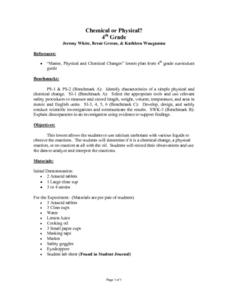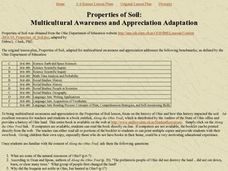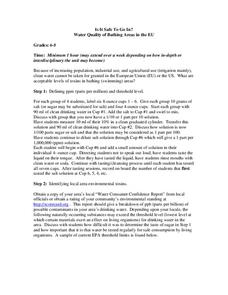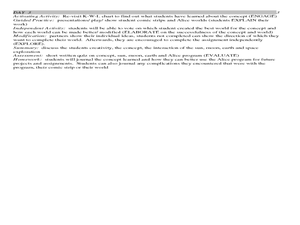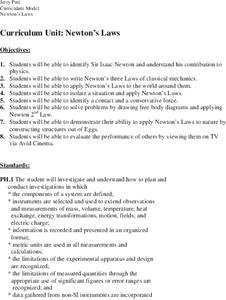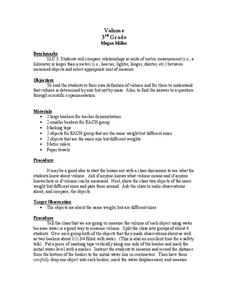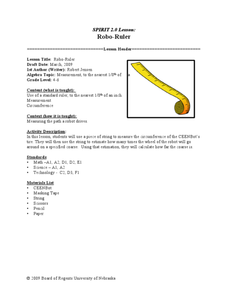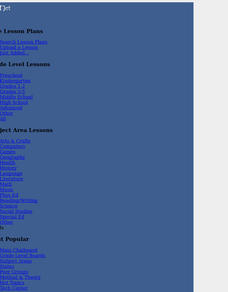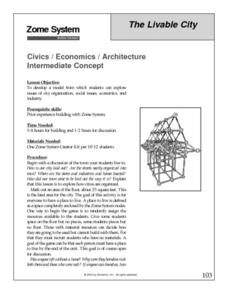Curated OER
Chemical or Physical?
Fourth graders make observations of the reactions that happens between calcium carbonate and various liquids. During the experiment the students determine if there is a chemical change, a physical reaction, or no reaction when they mix...
Curated OER
Properties of Soil
Students encounter various pieces of knowledge utilizing lessons that addresses a diversity of learners with multiple intelligences. They cover various concepts: science, Earth, scientific inquiry, geometry, data analysis, probability,...
Curated OER
What Do You Know About Oceans?
Learners brainstorm and discuss what they know about oceans and seas, read poem My Ocean Speaks by Olga Cossi, discuss narrator's feelings about ocean, write reflective journal entries about their experience or inexperience with the...
Curated OER
Vegetable Faces: A Guiseppe Archimboldo Portrait Study
Students create drawings of vegetable faces.In this early childhood lesson plan, students identify various vegetables, which they use as models to create drawings. Students experiment with the vegetable drawings by adding faces to their...
Curated OER
Traits
Sixth graders consider heredity. For this science lesson plan, 6th graders gain an understanding of certain physical traits are inherited from their parents through the genes.
Curated OER
Is It Safe To Go In? Water Quality of Bathing Areas in the EU
Students complete an experiment on water to study water quality. In this water quality lesson, students complete a taste test experiment about chemicals in water. Students then study their local water environments and recorded toxins....
Curated OER
Creating Weather Journals
Students create weather journals. In this weather science lesson, students use digital cameras to record the daily weather and write a paragraph in a weather journal.
Curated OER
Galapagos Islands
Students study the science and geography related to the Galapagos Islands. In this ecosystem lesson, students locate the Galapagos Islands on a world map and discuss its significance in history. Students complete a vocabulary sheet,...
Curated OER
Under the Sea
Students culminate a science and language arts unit by participating in a performance. In this performance instructional activity, students make costumes and scenery before performing a play entitled, "The Mystery of the Missing Jewel...
Curated OER
Does turnip curling always cause friction?
Third graders become familiar with the effects of force through curling. In this turnip curling instructional activity, 3rd graders experiment with a turnip curling stone on various surfaces. Students are assess with a new variable...
Curated OER
Facts and Myths about our Solar System
Sixth graders explore popular ideas about the Sun and Moon. In this space science lesson, 6th graders separate commonly accepted details about our solar system into facts and myths. Students research a particular idea and...
Curated OER
What's in that Cake?
Young scholars discover the methods scientists use to investigate Oceanic habitats. In this oceanography lesson, students utilize the Internet to identify deep sea submersibles and how they help scientists study the Charleston...
Curated OER
Inquiry-based Investigations into Pond Water Microorganisms
Students become familiar with common microorganisms and experience exploring the microbial world.
Curated OER
Newton's Laws
Young scholars examine and discuss Newton's Laws and discover his contribution to physics. In groups, they participate in an experiment in which they much apply the Laws to the world around them. They describe contact and conservative...
Curated OER
Volume
Third graders complete scientific investigation to determine what volume is and how it is determined by size not by mass. They discuss what they know about volume before proceeding with the demonstration and experimentation. After the...
Curated OER
Robo Ruler
Students calculate measurements using different units and fractions. In this algebra lesson, students measure the path that a robot drives. They use a piece of sting to do their measurement and calculate the circumference of the robot's...
Curated OER
Weather
Students participate in a variety of mini-lessons including experiments, literature readings, physical education components, music, data gathering and recording and more to expose them to several themes of weather; i.e. water cycle,...
Curated OER
The Inside of an Apple
Students review the life cycle of apples before they study information about the inside of apples. They work in small groups to color and identify the parts of the inside of an apple. Finally, they use real apples to have an hands on...
Curated OER
The Laws of Thermodynamics
Students investigate the concept of a thermodynamic system. The difference between a state and phase is defined as part of the experimental explanations given in writing. Students conduct experiments to demonstrate laws of science like...
Curated OER
Exploring The Great Salt Lake
Second graders experiment with sand samples taken from a lake. They use this as part of an inquiry that is based on observations. The properties of the sand are observed in the lab and recorded in writing. Prior to the lab students...
Curated OER
Cell Energy-Bubbling Plants
Middle schoolers discuss the process of photosynthesis in plants and that oxygen is produced as a by product. They observe underwater Elodea plants "breathing" in a hands-on activity. After setting up the experiment, they observe the...
Curated OER
Photographs of Life Cycle of a Butterfly
In this science worksheet, students look at the large color photographs and read simple captions which show the life cycle of a butterfly.
Curated OER
States of Matter
First graders experiment with different states of matter in order to observe the changes in matter. In this states of matter lesson plan, 1st graders see and explain how solids, liquids, and gases change.
Curated OER
Characteristics of Energy
Students explore Earth science by completing energy worksheets in class. In this energy forms lesson, students identify and define a list of energy vocabulary terms and a K-W-L chart. Students view a matter video clip in class and...
